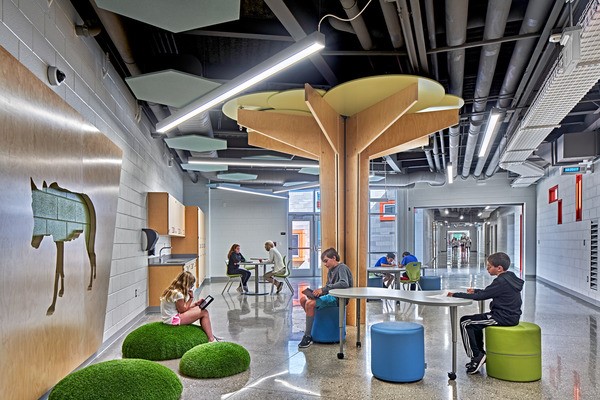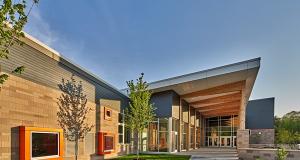HOLLAND, Michigan (August 27, 2022) –– GMB Architecture + Engineering, a 53-year-old firm of educational planners, architects and engineers, announces the completion and opening of Ludington Elementary School in West Michigan, in time to welcome students and educators from across the district for the new school year. Ludington Area Schools' three elementary buildings were over 50 years old and in need of significant, costly renovations. Instead, the community made the decision to consolidate the three schools into one new, centralized facility that takes a forward-looking approach to curriculum design, facilities planning and classroom design.
The resulting building designed by GMB Architecture + Engineering establishes a learning ecosystem within the surrounding community, and breaks down the classroom wings into smaller, grade-level centered neighborhoods that feel more approachable to an elementary-aged student. Extended learning areas and cozy nooks throughout the building reinforce the idea that learning can happen anywhere on campus.

The team designed the new elementary school spaces to be flexible and transitionally appropriate for each age group, as well as accommodating for learning in every space. The extended learning areas provide opportunities for students to find their place and help propel the district in a new direction around collaborative learning. Built-in nooks were designed within the walls outside the media center as well as window seats in the classrooms, presenting ways for students to find their niche in a big building and to provide that amenity for quiet/calm down/individual space within the classroom without taking up square footage.
Consolidating three elementary schools under one roof, at 154,820 square feet, this project is many times larger than the previous buildings were individually. While a consolidated campus can seem quite massive, the GMB team deployed an innovative design to break down the classroom wings into smaller, grade-level centered neighborhoods that feel more approachable to an elementary student. All of the shared amenities and special programs are organized along a center spine that connects all the neighborhoods together, creating a clear wayfinding path and circulation loop around the building. Through a planning and architectural design lens, the scale of every element and space was thoughtfully considered for the students and teachers inhabiting the building. Technically, there are no corridors in the entire building, as everything is considered an extended learning area, yet compartments are thoughtfully broken down and egressing and exiting occurs in a natural flow.
Student safety was a focus for this new facility as well, and the site and building were designed to have layers of security measures while continuing to reinforce a welcoming community that supports the whole child. The entire building is equipped with electronic hardware (no keys) at all occupied spaces allowing for more efficient access control and monitoring and the building can be locked down with the push of a button. Each neighborhood is also equipped with a set of security doors that can be locked down as another layer of protection as well as other strategically placed security doors that don’t impede on building egress.
All the classroom wings connect immediately outside to the playground area from the extended learning areas, and the entire property is surrounded by forest, trails, and natural space. Each wing of the building provides a direct connection to the outdoors, buffered by a playground for safety and supervision, to encourage outdoor learning and play. an additional outdoor learning space with corridor access and featuring overhead garage doors on several classrooms that open to the outside.
The site itself is unique not only for the natural landscape encircling the property, but also for its historical significance and context. The land contains an ancient Native American burial ground, and the team saw an opportunity to connect the school to that history as well as connect the community to the people who lived there long ago. The native history was also woven into the building, connecting a modern structure with the community and deep history that came before. Each of the classroom wings is like a micro-community within the building, and were therefore each given an identity, naming them after an animal that was important to the Native American tribe and the land. Motifs, colors, wayfinding signage, and community embellishments all tie to animals native to the area, from the owl to the wolf to the bear, and connect to the school’s grade levels.
With the idea that learning would happen for students outside the building as much as inside, just like the people who called the land home long ago, the surrounding forest was envisioned as an outdoor laboratory, with trails and guides for students to learn about the native flora and fauna inhabiting the site. Local foresters created a forestry management plan for the property, clearing some invasive species and thoughtfully creating trails throughout the wooded area. A biology teacher from Ludington High School created a class project to inventory and record the native flora and fauna to be used in the elementary science curriculum.
This new facility creates a hub for the community, fostering inclusion and encouraging relationship building that promotes a sense of community pride. Large-volume spaces like the cafeteria and gym accommodate events outside of school hours and nestling the facility in the surrounding forest with bike trails, outdoor play areas, a disc golf course, and access to restrooms created an opportunity for the community to use the entire property like a park.
Learn more about GMB and the learning ecosystems they’re creating at www.gmb.com.
About GMB
Opportunity for all. That’s the world GMB strives to see. Our integrated team of educational planners, architects and engineers are just one part of the learning ecosystem that will make that happen. GMB believes education provides transformational opportunities for our communities, industries and our world. GMB is evolving our business to foster a culture of continual learning inside and outside our organization.
As a learning organization structured for ideation, innovation, and sharing of knowledge, GMB’s hubs of experts in Grand Rapids, Holland and Royal Oak, Michigan, and Indianapolis, Indiana, design and engineer projects throughout North America.
Whether in a building or a park, in a course or a career, we believe it takes an ecosystem of people, companies, communities and ideas to foster learning opportunities for students of all ages. We believe that by investing in our future and creating learning ecosystems, we can provide opportunity for all. Learn more at www.gmb.com.
###

